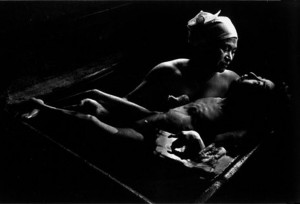The Book
In 1971, Smith returned to Japan for a third time and lived in the small fishing village of Minamata, with his wife Aileen. Although they planned to stay for only three months, the couple stayed for three years. Smith’s photos on a mercury poisoning scandal in Minamata were published in Asahi Camera, Camera 35, and Life in an article called “Death-Flow from a Pipe,” and in this book called “Minamata: The Story of the Poisoning of a City.” The photos brought world attention to the Minamata disease caused by mercury being released into the ocean by a company called Chisso. The most famous photo was that of Kamimura Tomoko in the bath, cradled by her mother. Born in 1956, Tomoko suffered from mercury poisoning. Mercury had entered her bloodstream through the placenta, leaving her blind, deaf, and with useless legs. Smith heard about Tomoko’s daily afternoon bath and asked her mother if he could photograph them. He carefully checked the bath’s lighting, which came through a dark window. Smith determined that three in the afternoon would be the best time, and took the famous photo in December 1971.
Smith and his wife were attacked and injured in January 1972 during a confrontation between mercury poisoning victims and Chisso employees at the factory in Goi. Victims were violently evicted from Chisso property. Smith had to seek medical treatment in the U.S. for his injuries. Ken Kobre described the attack in an essay at the Masters Exhibition website: “Smith almost lost his eyesight covering the story. He and his wife, armed with camera and tape-recorder, accompanied a group of patients to record a meeting the group expected to have with an official of the company. The official failed to show up. “But,” Smith related, “suddenly, a group of about 100 men, on orders from the company, crowded into the room. They hit me first. They grabbed me and kicked me in the crotch and snatched the cameras, then hit me in the stomach. Then they dragged me out and picked me up and slammed my head on the concrete.” Smith survived, but with limited vision in one eye.
About the Photographer
W. Eugene Smith (William Eugene Smith), 1918-78, American photojournalist, is considered one of the principal masters of modern photojournalism. The distorted newspaper coverage of his father’s suicide made him determined to seek absolute personal honesty in his own documentary work. After a short time on the staff of Newsweek, he freelanced for many leading magazines, including Life, Collier’s,and Harper’s Bazaar, and for the New York Times. He worked with miniature (35 mm) cameras and developed an innovative flash technique that enabled him to produce indoor photographs having the appearance of natural or lamp light. Smith’s photographic record of events in the Pacific theater of World War IIis ranked among the grimmest and most powerful visual indictments of war. Severely wounded in 1945, he was unable to work for two years. The first photograph he made upon recuperation (of his two children walking toward a sunlit area on a wooded path) was chosen as the final work in the “Family of Man” exhibition (Mus. of Modern Art, New York City; 1955). From 1947 to 1954 Smith worked full time for Lifecreating a series of major photo essays, including “Trial by Jury” (1948), “Country Doctor” (1948), “Nurse Midwife” (1951), “The Reign of Chemistry” (1953), and “A Man of Mercy” (concerning Albert Schweitzer, 1954). With a Guggenheim Fellowship he created his celebrated “Pittsburgh” essay (1956). In 1963 Smith began an intensive photographic study of Japan. While documenting the maiming effects of mercury poisoning from factory pollution on the residents of the fishing village of Minamata (1971-73), he was brutally beaten; as a result he lost his sight temporarily in 1974.Smith said, “Photography is a small voice, at best, but sometimes-just sometimes-one photograph or a group of them can lure our senses to awareness. Much depends on the viewer; in some, photographs can summon enough emotion to be a catalyst to thought. Someone-or perhaps many-among us may be influenced to heed reason, to find a way to right that which is wrong, and may even search for a cure to an illness. The rest of us may perhaps feel a greater sense of understanding and compassion for those whose lives are alien to our own. Photography is a small voice. I believe in it. If it is well conceived, it sometimes works.”
In January 1972, Smith was attacked by Chisso employees near Tokyo, in an attempt to stop him from further publicizing the Minamata disease to the world[3]. Although Smith survived the attack, his sight in one eye deteriorated. Smith and his Japanese wife lived in the city of Minamata from 1971 to 1973 and took many photos as part of a photo essay detailing the effects of Minamata disease, which was caused by a Chisso factory discharging heavy metals into water sources around Minamata. One of his most famous works, Tomoko Uemura in Her Bath, taken in December 1971 and published a few months after the 1972 attack, drew worldwide attention to the effects of Minamata disease






